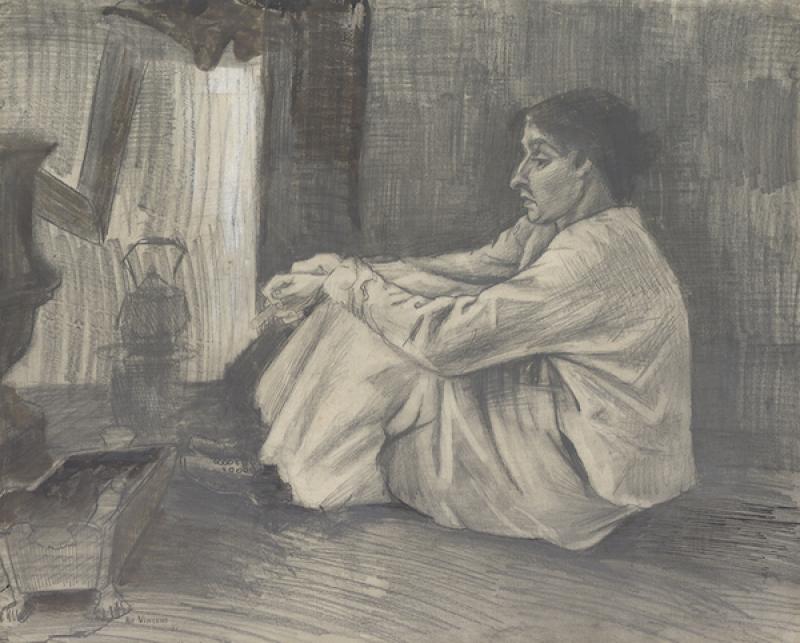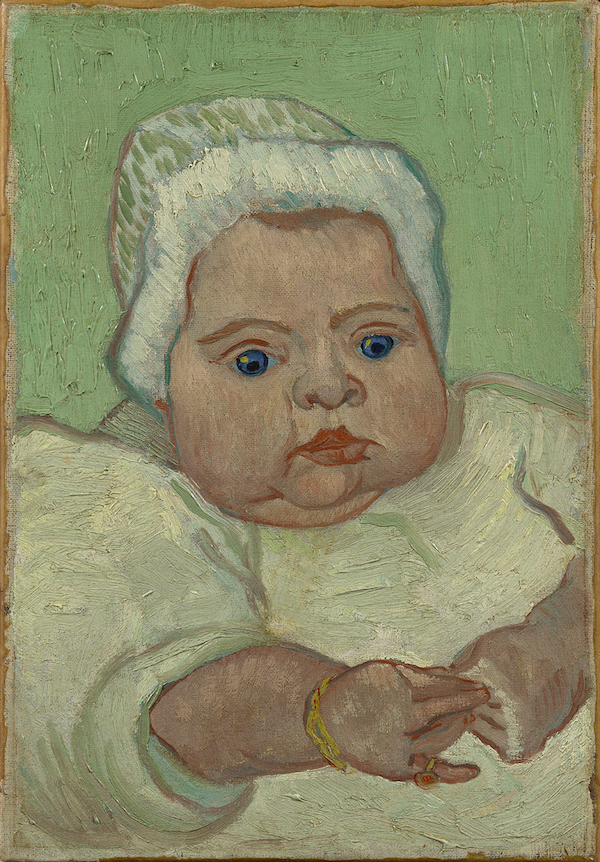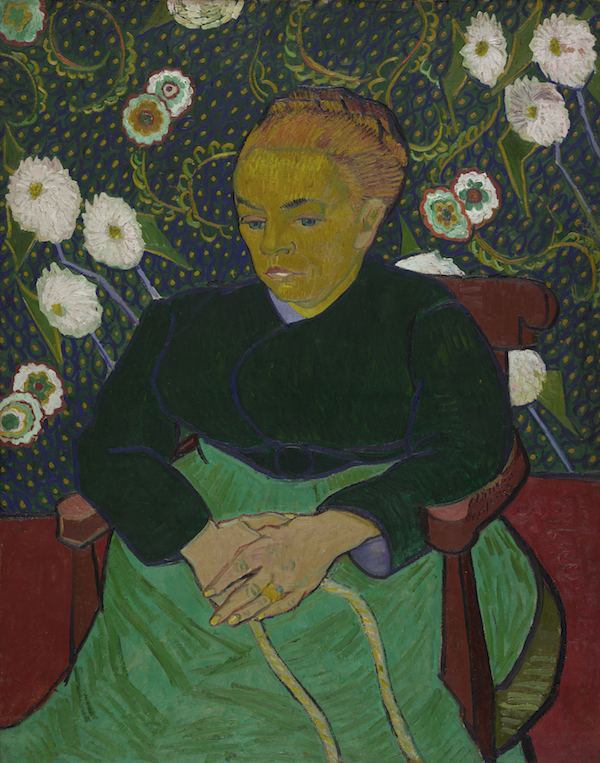Van Gogh’s Inner Circle, Noordbrabants Museum review - the man behind the art | reviews, news & interviews
Van Gogh’s Inner Circle, Noordbrabants Museum review - the man behind the art
Van Gogh’s Inner Circle, Noordbrabants Museum review - the man behind the art
Light on paintings, heavy on the biography

Vincent van Gogh (b. 1853) could be difficult, truculent and unconventional. He battled with mental illness and wrestled with questions of religion throughout his life. But on good form he was personable. He was said to be an excellent imitator with a wry sense of humour, and was a loyal (if often fierce) friend and family relation.
Van Gogh’s minister father adhered to a strand of Protestantism from the Dutch city of Groningen which instilled early in him strong associations between nature and God. But this association could also be playful, blithe. One of the first vitrines in the exhibition holds sketch books from 1874, sweetly filled with animals and insects for Betsy Tersteeg, the four year old daughter of Herman Gijsbert Tersteeg, his manager at the art dealership Groupil, at which he worked from the age of 16 until his dismissal in 1875. They include sketches of a snail, a cricket, a dragonfly and a nesting bird. While they are arduously done, the creatures appear inquisitive, almost as if ready to be brought to life by a child’s imagination.
 Later sketches from the year he spent living with Sien Hoornik, a former prostitute, in The Hague show a different kind of attachment — sexual and semi-marital. They give an insight into the closest he came to a domestic, if typically unconventional, arrangement. In Saying Grace, 1883, he depicts Sien seated at a table. Her worn hands are clasped, her eyes closed and her lips tightly pressed together; her apron is patched but she is dignified. A Mother Suckling her Child, 1882, depicts Sien breastfeeding. Her arms are wrapped protectively round the baby’s body. Her expression of concentration is edged with concern but the baby’s eyes are blissfully closed. Small details such as the tender arch of an ear, and the baby’s instinctive grasp of her breast describe van Gogh’s close observation and the intimacy between mother, child and artist. Another, Girl Kneeling by a Cradle, 1883, shows Sien’s daughter at the foot of the cot of her younger sibling. Her back is to us so we cannot tell from her face whether she is entranced or threatened, but her posture is relaxed, her head tilted downwards and her arms free from tension. The air is reverent, she is almost at prayer.
Later sketches from the year he spent living with Sien Hoornik, a former prostitute, in The Hague show a different kind of attachment — sexual and semi-marital. They give an insight into the closest he came to a domestic, if typically unconventional, arrangement. In Saying Grace, 1883, he depicts Sien seated at a table. Her worn hands are clasped, her eyes closed and her lips tightly pressed together; her apron is patched but she is dignified. A Mother Suckling her Child, 1882, depicts Sien breastfeeding. Her arms are wrapped protectively round the baby’s body. Her expression of concentration is edged with concern but the baby’s eyes are blissfully closed. Small details such as the tender arch of an ear, and the baby’s instinctive grasp of her breast describe van Gogh’s close observation and the intimacy between mother, child and artist. Another, Girl Kneeling by a Cradle, 1883, shows Sien’s daughter at the foot of the cot of her younger sibling. Her back is to us so we cannot tell from her face whether she is entranced or threatened, but her posture is relaxed, her head tilted downwards and her arms free from tension. The air is reverent, she is almost at prayer.
As a teacher, van Gogh could also be personable. While living in Nuenen (1884-1885), he taught painting to a small group in Eindhoven. While he could be dry and sarcastic, it was clear he cared deeply for his students' development. He suggested to Anton Kerssemakers that he join him for three days’ painting, and convinced Willem van de Wakker’s employer to allow him time off to improve his painting. In many ways the arrangement was reciprocal, for he too was indebted to them. A third, the goldsmith Antoon Hermans, lent him "beautiful" objects that he made into still lives for his students to paint. He too painted from these and offered a still-life to Theo to adorn his walls.
Nevertheless, his work took primary importance and his friendships were often tied up with art. Notoriously, this association could be fraught. He broke with his friend, artist Anthon van Rappard over whether his representation of the De Groot-van Rooij family (who he depicted in The Potato Eaters, 1885). Later, when he moved to Paris in 1886, he struck up friendships with artists such as Camille Pissarro, Paul Signac, Émile Bernard and Henri Toulouse-Lautrec. Bernard especially was a close friend with whom he exchanged paintings — but later, when Bernard's work took a religious turn, van Gogh's criticism was merciless. Yet it was common among his circle for such subjects to elicit strong emotions. The year van Gogh died, Toulouse-Lautrec challenged artist Henry de Groux to a duel for criticising van Gogh’s paintings in an exhibition. The duel was only dropped when Signac waded in, threatening to kill de Groux if Toulouse-Lautrec was killed.
 More than 900 of van Gogh’s letters survive, over two thirds of them addressed to his art dealer brother, Theo, who was younger by four years and supported him financially throughout much of his artistic career. The brothers were close, but correspondence was important for both sentimental and practical reasons. Given the contingencies his peripatetic existence placed upon the practicalities of his artistic work, it is no surprise that, towards the end of his life, while living in Arles (1888-1889) he developed a close relationship with the man who managed the town's deliveries. All of van Gogh's correspondence would have gone through the hands of Joseph Roulin who also organised transport of his paintings: in Arles he was literally van Gogh's lifeline to the outside world. During his time in Arles, the Roulin family (Joseph and his wife Augustine, Armand, Camille and Marcelle) became the subject of 25 paintings. The lavish portrait, Madame Roulin Rocking the Cradle, 1889 (pictured left) hangs adjacent to Portrait of Marcelle Roulin, 1888 (pictured above) Madame Roulin’s attention is focussed on the cradle out of frame, and the flower motif background lend the portrait a lush, pastoral intensity. Marcelle appears as a chubby, bulbous-eyed little chap. His pout and double chin amply show the affection lavished on him; and his fingers pinch each other in a maladroit manner typical of babies learning to control their bodies.
More than 900 of van Gogh’s letters survive, over two thirds of them addressed to his art dealer brother, Theo, who was younger by four years and supported him financially throughout much of his artistic career. The brothers were close, but correspondence was important for both sentimental and practical reasons. Given the contingencies his peripatetic existence placed upon the practicalities of his artistic work, it is no surprise that, towards the end of his life, while living in Arles (1888-1889) he developed a close relationship with the man who managed the town's deliveries. All of van Gogh's correspondence would have gone through the hands of Joseph Roulin who also organised transport of his paintings: in Arles he was literally van Gogh's lifeline to the outside world. During his time in Arles, the Roulin family (Joseph and his wife Augustine, Armand, Camille and Marcelle) became the subject of 25 paintings. The lavish portrait, Madame Roulin Rocking the Cradle, 1889 (pictured left) hangs adjacent to Portrait of Marcelle Roulin, 1888 (pictured above) Madame Roulin’s attention is focussed on the cradle out of frame, and the flower motif background lend the portrait a lush, pastoral intensity. Marcelle appears as a chubby, bulbous-eyed little chap. His pout and double chin amply show the affection lavished on him; and his fingers pinch each other in a maladroit manner typical of babies learning to control their bodies.
Van Gogh’s Inner Circle is on show at 's-Hertogenbosch — within easy reach of many other sites of biographical interest: Zundert, where he was born and spent the first years of his life; Etten-Leur, where he first registered in 1881 as an artist at the town hall; and Nuenen, where he painted The Potato Eaters and Congregation Leaving the Reformed Church in Nuenen, 1884. For those interested in van Gogh’s upbringing, his life and times this is convenient, for what comes through in the show is the extent to which he was reliant upon the friends and family who surrounded him. The exhibition is far from a run-down of his greatest hits, but rather a deeply researched, dedicated show sensitively curated by Sjraar van Heugten and Helewise Berger, squarely aimed at those who want know more about the man behind the art.
- Van Gogh's Inner Circle at Noordbrabants Museum until 12th January 2020
- Read more visual art reviews on theartsdesk
Add comment
The future of Arts Journalism
You can stop theartsdesk.com closing!
We urgently need financing to survive. Our fundraising drive has thus far raised £49,000 but we need to reach £100,000 or we will be forced to close. Please contribute here: https://gofund.me/c3f6033d
And if you can forward this information to anyone who might assist, we’d be grateful.

Subscribe to theartsdesk.com
Thank you for continuing to read our work on theartsdesk.com. For unlimited access to every article in its entirety, including our archive of more than 15,000 pieces, we're asking for £5 per month or £40 per year. We feel it's a very good deal, and hope you do too.
To take a subscription now simply click here.
And if you're looking for that extra gift for a friend or family member, why not treat them to a theartsdesk.com gift subscription?
more Visual arts
 'We are bowled over!' Thank you for your messages of love and support
Much-appreciated words of commendation from readers and the cultural community
'We are bowled over!' Thank you for your messages of love and support
Much-appreciated words of commendation from readers and the cultural community
 Photo Oxford 2025 review - photography all over the town
At last, a UK festival that takes photography seriously
Photo Oxford 2025 review - photography all over the town
At last, a UK festival that takes photography seriously
![SEX MONEY RACE RELIGION [2016] by Gilbert and George. Installation shot of Gilbert & George 21ST CENTURY PICTURES Hayward Gallery](https://theartsdesk.com/sites/default/files/styles/thumbnail/public/mastimages/Gilbert%20%26%20George_%2021ST%20CENTURY%20PICTURES.%20SEX%20MONEY%20RACE%20RELIGION%20%5B2016%5D.%20Photo_%20Mark%20Blower.%20Courtesy%20of%20the%20Gilbert%20%26%20George%20and%20the%20Hayward%20Gallery._0.jpg?itok=7tVsLyR-) Gilbert & George, 21st Century Pictures, Hayward Gallery review - brash, bright and not so beautiful
The couple's coloured photomontages shout louder than ever, causing sensory overload
Gilbert & George, 21st Century Pictures, Hayward Gallery review - brash, bright and not so beautiful
The couple's coloured photomontages shout louder than ever, causing sensory overload
 Lee Miller, Tate Britain review - an extraordinary career that remains an enigma
Fashion photographer, artist or war reporter; will the real Lee Miller please step forward?
Lee Miller, Tate Britain review - an extraordinary career that remains an enigma
Fashion photographer, artist or war reporter; will the real Lee Miller please step forward?
 Kerry James Marshall: The Histories, Royal Academy review - a triumphant celebration of blackness
Room after room of glorious paintings
Kerry James Marshall: The Histories, Royal Academy review - a triumphant celebration of blackness
Room after room of glorious paintings
 Folkestone Triennial 2025 - landscape, seascape, art lovers' escape
Locally rooted festival brings home many but not all global concerns
Folkestone Triennial 2025 - landscape, seascape, art lovers' escape
Locally rooted festival brings home many but not all global concerns
 Sir Brian Clarke (1953-2025) - a personal tribute
Remembering an artist with a gift for the transcendent
Sir Brian Clarke (1953-2025) - a personal tribute
Remembering an artist with a gift for the transcendent
 Emily Kam Kngwarray, Tate Modern review - glimpses of another world
Pictures that are an affirmation of belonging
Emily Kam Kngwarray, Tate Modern review - glimpses of another world
Pictures that are an affirmation of belonging
 Kiefer / Van Gogh, Royal Academy review - a pairing of opposites
Small scale intensity meets large scale melodrama
Kiefer / Van Gogh, Royal Academy review - a pairing of opposites
Small scale intensity meets large scale melodrama
 Jenny Saville: The Anatomy of Painting, National Portrait Gallery review - a protégé losing her way
A brilliant painter in search of a worthwhile subject
Jenny Saville: The Anatomy of Painting, National Portrait Gallery review - a protégé losing her way
A brilliant painter in search of a worthwhile subject
 Abstract Erotic, Courtauld Gallery review - sculpture that is sensuous, funny and subversive
Testing the boundaries of good taste, and winning
Abstract Erotic, Courtauld Gallery review - sculpture that is sensuous, funny and subversive
Testing the boundaries of good taste, and winning
 Edward Burra, Tate Britain review - watercolour made mainstream
Social satire with a nasty bite
Edward Burra, Tate Britain review - watercolour made mainstream
Social satire with a nasty bite

Comments
Just amazing how he could
Van Gogh is the most amazing